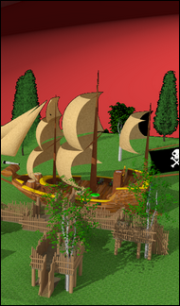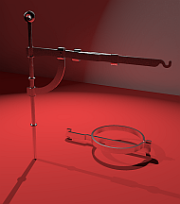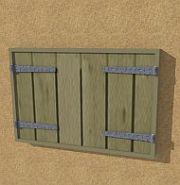Filed under: In English | Tags: birch, furniture factory, gluing, glulam, IKEA, kiln & dry, knock-down furniture, planing, producing furniture, transportation
The industrial process of producing furniture – Ecology – Part IV (of VI)

The logs are tranported to the saw-mill and the boards to the kiln and dry-facilities.
Here you can see how the logs are processed within a modern saw-mill:
http://www.lumberbasics.org/02lbrman/01.htm
The boards are then transported to a kiln & dry-facility.

The boards are dried in the kiln & dry-facilities and delivered to the glulam-factory.
There the boards are dried in a chamber equipped with fans which circulate the humid air and the chamber has a temperature between 40 – 70 degrees Celsius.
The process takes about 2 weeks for coniferous wood and 3 weeks for hardwood. The process is very energy-intensive.
From the kiln-and-dry the boards go to the glulam-factory.

When the boards have arrived into the glulam factory, they are planed, sawn into stripes, cut away the unwanted knots and miscoloured parts, cut to lengths according to standards, sorted again, glued into large sheets, sanded, packed again according to sorts and standards, transported to different furniture factories.
In the glulam factory, the boards are sawn into stripes and planed into measures.
After that they are cut to lengths – while removing the unwanted knots, miscoloured parts etc..
During this process the pieces are also sorted according to different standards.
After that the length- and quality-sorted components are sorted according to texture, grain and colour, which differs, depending on in what kind of soil the tree has grown, how it is sawn, radially or tangentially.
Also the angle of the originally sawn board in relation to the annual rings of the log, the irregular growth of the tree affects how the wood reflects light.
All this is done because the surface of the furniture should not give the zebra-stripe-look in the finnished product. The work of sorting has to be done by the human eye, in order to decide what are the beauty, harmony and art aspects in the final furniture.
Believe me, when you work with birch, the description above has only scratched the surface on how to create beautiful and artistic furniture.
The glulam sheets are then taken further to a furniture factory…

The glulam sheets are processed in the furniture factory into ready or knock-down furniture.
… where they are processed further; sawn to measure, drilled and shaped, varnished and packed.

Finally the furniture arrive to the warehouse, from where it is distributed to the shops.
The whole process seem to be complicated, and it is, but nowadays it really is so, that one manufacturer has one segment that he specialize himself.
Earlier the process was more like “from the forest to a ready product” at one single large factory, but as one furniture factory can produce tens of thousands of pieces of the exact same table, it is not interested in any other raw-material than what it needs for that table as legs. It is not interested in sorting out material of other dimensions, nor selling material cannot utilize and so on.
There are even factories which have only one automatic line for one purpose only. As an example can be mentioned a factory which only lacquers table-legs, with a capacity of 25.000 legs per day.
The point here is that all cards are dealt once more, as soon as the price of the fossil energy goes up. The winners in that situation will be those factories that are near each other. This is because there is so much transportation involved in the process of delivering a product from the forest to the consumer.
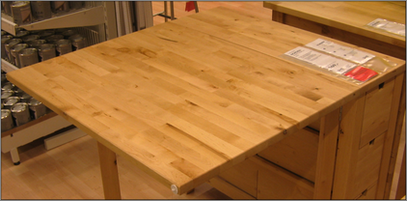
A typical factory-made furniture of IKEA. The natural birch is almost white, but as it has so many shades of colour, the factories shades the varnish toward brown.
An example:
The most successful company, IKEA, makes quite nice birch furniture. The birch comes mainly from Russia.*All* their birch-products are made in China. After that they are transported to different parts of the world.
Next time, when you see a birch table from IKEA, you will see the price, but hopefully also the amount of non-renewable fossil energy used in its production.

"I am Tarzan - You are logging my trees?!!!"
Our beautiful friend has issues:
“And you call those pathetic squares glued together… Design?
Look at nature, the most beautiful thing ever… where do you see squares?
Hmm!?
Nature has round forms and it is beautiful, do not try to mess around with it!!
You hear me?!!
I asked; Do you hear me? You.., you..”
OK, you can take a tree here and there, but be careful. Be very careful – or else…”
______________________________________
To be continued…
Share this post!
Filed under: band-saw, ecology, environment, Finland, In English, logging, sawing, sustainable, wood engineering | Tags: band-saw, Finland, forwarder, framesaw, harvester, logging, sawing, sawmill, windmill, woodworking
Ecological – Part III (of VI)
Let us look at the different processes: Woodworking – Logging and sawing

The harvester, on the left. It cuts the tree, debranches it, sprays some urea on the stump, and paint-stripes on the end of the log.
The different colors on the ends of the logs, the paint-stripes, tell the forwarder-operator the length and sort of each tree.
The forwarder-operator can thus sort the logs by picking up one sort at a time.
The wagon of the forwarder can load about ten or more cbm [cubic meters] per time. The logs are taken to the nearest place where the log-trucks can be loaded.
In this video, the harvester cuts, debranches and debarks the logs:
http://www.youtube.com/watch?v=qYlBbLDL5dE
The debarking of the log has many positive aspects when logging in the warm season; the log is not so easily attacked by insects and fungi, the bark that remains in the forest will stay there as nutrients, the mass of the load is reduced by 7 – 8 %, the weight even more as the log dries much faster without bark.
Here you can see how a forwarder works:
http://www.youtube.com/watch?v=0EnO7f4Vxb8&feature=related
Both the harvester and the forwarder are computerized.

To the left is a “Walking Harvester”
http://firrs.blogspot.com/2007/10/finnish-subsidiary-of-john-deere-has.html
The university of Tampere (Finland) and a Finnish company developed a “Walking Harvester” before John Deere bought the company. This harvester is meant for steep hillsides, where safety is very essential when logging in such an environment, and also the environment itself needs to be taken care of. If the earth is very scarred at steep hillsides, the heavy rain and fast melting snow can endanger the soil before nature has taken care of the “scars”. If the soil that keeps the trees growing runs down together with the water, it takes thousands of years to recover the forest – if ever.
The best known example of this are the former dense cedar-forests of Lebanon. First the Foinikians logged the main forests and after that, the Romans logged the rest. After the hills where barred, there was nothing that kept the soil in place.
There are different methods to keep the forests growing for centuries to come. The methods of logging, depends on if the forest is at a big lake or on steep hill. As a rule, forest are logged in zig-zag-corridors, so that the wind can’t get too strong, but blow mainly above the forest.

On the left, a Roman saw-mill found in Asia Minor.
On the right, a commercially made band-saw, Serra. The kerf (the gap that becomes saw-dust) is about 2 mm when you saw with a bandsaw.
A typical kerf for circular log-saws and frame-saws is 5 – 6 mm. It might seem to be a small difference, but the fact is that from one medium-size log, you can get one extra board. That makes a big difference at the end of the day – especially if the logs are of the highest quality such as knotless logs. The knotless boards, for example which the carpenters make boats from, do not come cheap.
The downside with a band-saw is that it is slower, but one thing which compensates this fact is that it uses much less electrical power.

The framesaw, to the left, has a set of fixed saw-blades, 5 – 11 blades. The framesaw through-saws the whole log into unsquared boards simultaneously.
The circular logsaw, saws fast, but only one board at time.

Laser technology is used in many different types of processing units in a modern saw-mill.
Usually the saw-mill needs a big yard in order to keep the logistics in good order.
To be continued…
Share this post!
Filed under: DIY, ecology, energy saving, environment, In English, wood engineering | Tags: chip-board, DIY, ecology, energy, furniture, hard-wood board, kiln, saw-mill, stack, sustainable
‘Ecological’ – the sustainability approach – Part II (of VI)
Well, there is no certain answer, but it all depends on many factors as told in Part I;
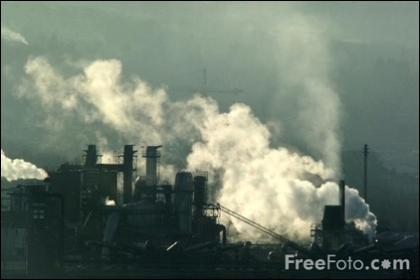
A chipboard factory
1) The chip-boards, or particleboards, are usually made from chips of some waste from some saw-mill or such. The glue is a combination of chemicals and the process of making chip-boards uses a lot of energy. The laminate is plastic. You maybe need to replace this kind of table-top every 25 years.
The release of formaldehyde from the particleboards is also a great concern.

2) To saw a stone into measure and to make the final product smooth and the edges round = a lot of energy needed. The durability of the stone can be hundreds of years, if the house does not burn or somebody smash it down with a hammer.

A saw-mill
3) To make it from hardwood by yourself:
a) To buy a ready-glued sheet of hardwood, sawn into the dimensions needed. Then just sand the edges and such and coat it with something, or maybe just oil it. The coating has to be such that it will not give the food, or what ever you make on that table-top, any toxins. All sorts of lacquers or paint do not fit a kitchen. [To paint hardwood is a crime against humanity.]
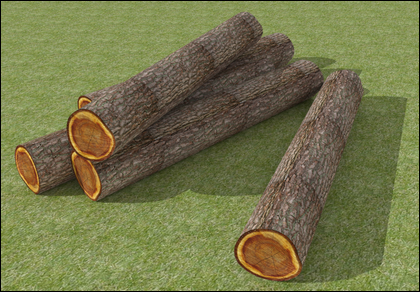
The logs should not lay directly on the ground.
If the logs are lying unbarked during summer, there is
a great risk of mold, blue-stain and insect attacks.
b) You buy hardwood boards. The boards are sawn with some amount of energy. The planks are put into a kiln and dried in a chamber specially built for that purpose.
You can use different hardwoods, in order to get different colour-patterns, to suit your thoughts of architecture and design. You need water-resistant glue, but considerably less than is used in chip-boards. You need quite many tools in order to press the boards together, plain and sand them. Then you need to coat it. After 25 years, you might to need to sand your table-top and coat it again.

A table-top of birch for a desk, size 100 cm by 200 cm
c) You buy fresh hardwood boards directly from the saw-mill. Or as we aim to do; make the logging, then saw the logs with a DIY-band-sawmill. The logs are through-sawn – still not squared. [You can also square them before drying. They dry faster but tend to be curved sideways. We will write later about “How to square hardwood”]

You stack the non-squared boards on sticks in a shady place. Depending on the thickness and what time of the year you have sawn the logs, the drying process takes 6 – 12 months when dried out-doors.

Planing birch
After that you have to square the boards and re-stack the boards inside a place which is constantly warm and dry. There the wood should dry for months, depending on the temperature. A minimum is about 4 – 9 months.

A stack of birch is opened and the first furniture components are selected for gluing the steps of the stairs that are under construction.
This can sound like a very time-consuming way to proceed, but after the first time, and when keeping the process continuous, you always have dry wood at your disposal. It is the cheapest and most energy efficient way to make any furniture.

The downside is that you need to buy a lot of tools and equipment to produce everything needed from scratch – from unsquared boards, that is. But to manage making different things from wood is a great hobby and very useful to learn and teach the kids.
Also teach your spouse, so that when you hear nagging about “we should buy this or that”, you can show where the tools are. Believe me; DIY makes wonders in a person’s personality. A silent spouse is something to have.
To be continued…
Share this post!
Filed under: DIY, ecology, energy saving, In English, wood engineering | Tags: disassemble, DIY, ecological, non-renewable, product, raw-material, recycled, self-made, sustainable, usabilty
1) A product that uses less energy than the other is not necessarily ecological. How’s that?
2) A table top of stone is not necessarily ecological. How’s that?
3) A wooden table is not necessarily ecological. How’s that?
Now for some provocative questions: You need to have a new table-top near your kitchen sink.
What is the best solution?
1) To buy a laminated chip-board.
2) To buy a table-top of stone.
3) To DIY.

An ecological product has to be seen as a whole process.
We have to consider:
– How much (non-renewable) energy has been used when it is produced?
– How much energy is needed when the product is used?
– The usability of the product – and is it really needed? Or is it just standing and taking space in the garage?
– Can it be self-made? Can it be made of recycled materials?
– How long is the life-time of the product?
– Can it be easily disassembled to usable raw-materials when it has ‘served out’?
– What can it, or parts of it, be used to when it can’t be used anymore in its original function?

Ecological – chip-board, stone or self-made?
To be continued…
Share this post!
Filed under: In English | Tags: alternative energy, animation, ceiling, eaves, eaves overhang, framing concept, insulation, patio, space, sustainable development
The animation presented here is of an undergoing design for the framing of a strawbale house.
Note that some room has been left above the ceiling for a layer of strawbales meant for insulation. The patio in front is covered generously to leave a sheltered space.
Once again, the eaves of the roof stretch out at least one meter away from the main body of the building.
 The inside of a post and beam house can be as attractive as the one presented here.
The inside of a post and beam house can be as attractive as the one presented here.
.
Share this post!
Filed under: In English | Tags: bearing house, DIY, gear reducer, kerf, salvage, shaft, sprocket, steel-rods, thread, wagon-frame

The ecological band-saw for logs
Comparing the ecological benefits of a self-made band-saw with a circular- or gang-saw.
– The band-saw needs a smaller electrical motor => less energy, even if it is not sawing as fast as the other types of saws.
– The thickness is more accurate for a band-saw, in realistic field conditions => the saw-worker does not need to add extra tolerances on each board.
– The kerf (the gap that the saw ‘eats’ making to saw-dust) is only 2 – 2,5 mm in a band-saw, and the other types of saws has a kerf of 5 – 6 mm. That means “an extra board of each log”.
– To saw big logs for some days, having a pile of big logs on one side of the mill, is not logistically difficult to do. And then having the small logs on the opposite side of the saw-mill, sawing them another day, means that you can easily change and plug a smaller saw-mill motor for those days.
– To obtain, store and change spare-parts is not a problem as long as you have been thinking about, and planned for, different situations from the beginning.
– The maintenance and sharping of band-saw-blades is easy.
What you need:
– Normal hand-tools + welding equipment
– to find the local Junkyard-Johnny

The rails (salvaged) and the foundation for them are very important.

The wagon-frame, (salvaged metal from Junkyard Johnny), has to be stabile. The wheels and ball bearings can be salvaged from any vehicle.

The elevator system has 2 steel-rods with threads, preferably durable against corrosion. [This is the only equipment you need to buy as new.]
Also a suitable chain and sprockets.

One or two used electrical motors 13 – 20 kW + bearing houses. Usually Junkyard-Johnny has a lot of these.

Used tyres + axels

A band-saw blade. (purchased)

If you want your saw-mill to be a deluxe model, you can also build a feed-motor to it. Any motor with a gear reducer of some sort, making the rotation slow, will do: from automated garage doors, old washing machines and similar stuff.
.
—
Share this post!
Filed under: In English | Tags: cob building, DIY, drawing, eco, ecology, ideas, plans, vernacular architecture, woodworking, ympäristö
The following picture was submitted to us by an avid fan, who understands our rabbit minds very well.
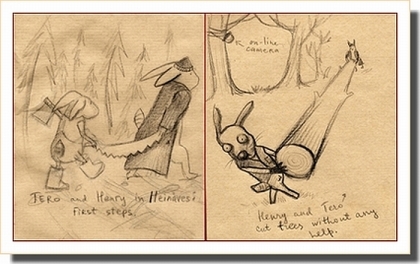
We will be working under cameras which will be connected to the Internet 24/7.
Filed under: Henryn palsta, suomeksi | Tags: arkkitehtuuri, ekologia, matkailu, metsätalous, olkipaali, rakenna itse, taloudellinen rakentaminen, vaapaa-aika, ympäristö, yrittäminen

Raaka-aineet tällaiseen 70:n neliön taloon maksavat alle 10.000 €
.
Ekorakentaminen – Osa 2:
Onko 10.000 €uron talviasuttavan talon rakentaminen mahdollista?
https://provillage.wordpress.com/2009/11/18/ekorakentaminen-osa-2-onko-10-000-euron-talviasuttavan-talon-rakentaminen-mahdollista/
Ekorakentaminen – Osa 3:
Olkipaali lämmöneristeenä täysin ylivoimainen
https://provillage.wordpress.com/2009/11/18/ekorakentaminen-osa-3-olkipaali-lammoneristeena-taysin-ylivoimainen/
Ekorakentaminen – Osa 8:
Olkipaalirakentaminen – perustustyöt ja alapohjan tuuletus
https://provillage.wordpress.com/2009/11/18/ekorakentaminen-osa-8-olkipaalirakentaminen-perustustyot-ja-alapohjan-tuuletus/
.
Simon Dalen talostaan ottamista valokuvista voit nähdä hieman viitettä siitä miltä talo voisi näyttää todellisuudessa, vaikkakin rakennusteknikka on erilainen:

Simon Dalen talon rakentaminen maksoi 3000 puntaa.
.
Täältä löydät lisää valokuvia Simon Dalen talosta:
https://provillage.wordpress.com/2009/11/24/luonnonmukainen-kyla-lansi-walesissa-sai-luvat-osa-2/
Kysymyksiä?
—————————-
Filed under: In English | Tags: 3D-modelling, cob building, DIY, drawing, ecology, Google, ideas, plans, vernacular architecture, woodworking
Some of the models for the project are now viewable in the Google 3D Warehouse.
This is only the beginning. I will try to upload one picture per week mainly on the topics which we have covered and will be covering in our blog in the future. Things have been progressing at such a pace that we have to collect our marbles and put them into some reasonable order again.
– Tero
………
Filed under: In English, strawbale building | Tags: alternative energy, eco, electronics, Finland, low technology, low-impact, strawbale building, sustainable development, vernacular architecture, woodworking
When having electrics in a straw bale home, one will need to know how to install it, as it might might be so that electricians will not necessarily have earlier experience with straw bale structures.
All of the wiring is to be hidden behind the plastered wall, or made to run in required places behind a special panel, so it is better to get it done right the first time. The panel solution also makes it easier to fix faulty wiring, if the need arises.

The wiring can also be placed to run in a tube which makes the installation easier.
.
—
Share this post!






